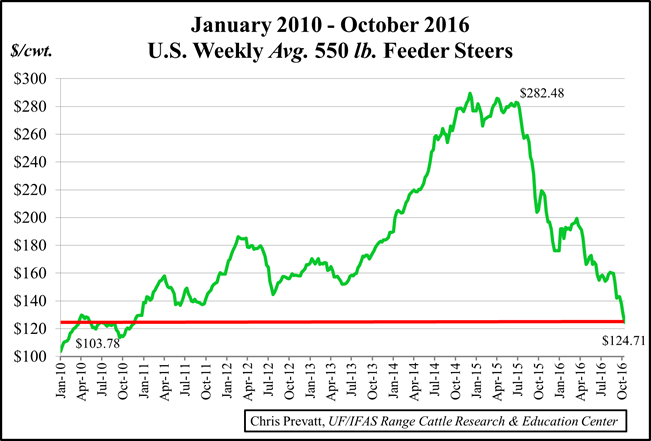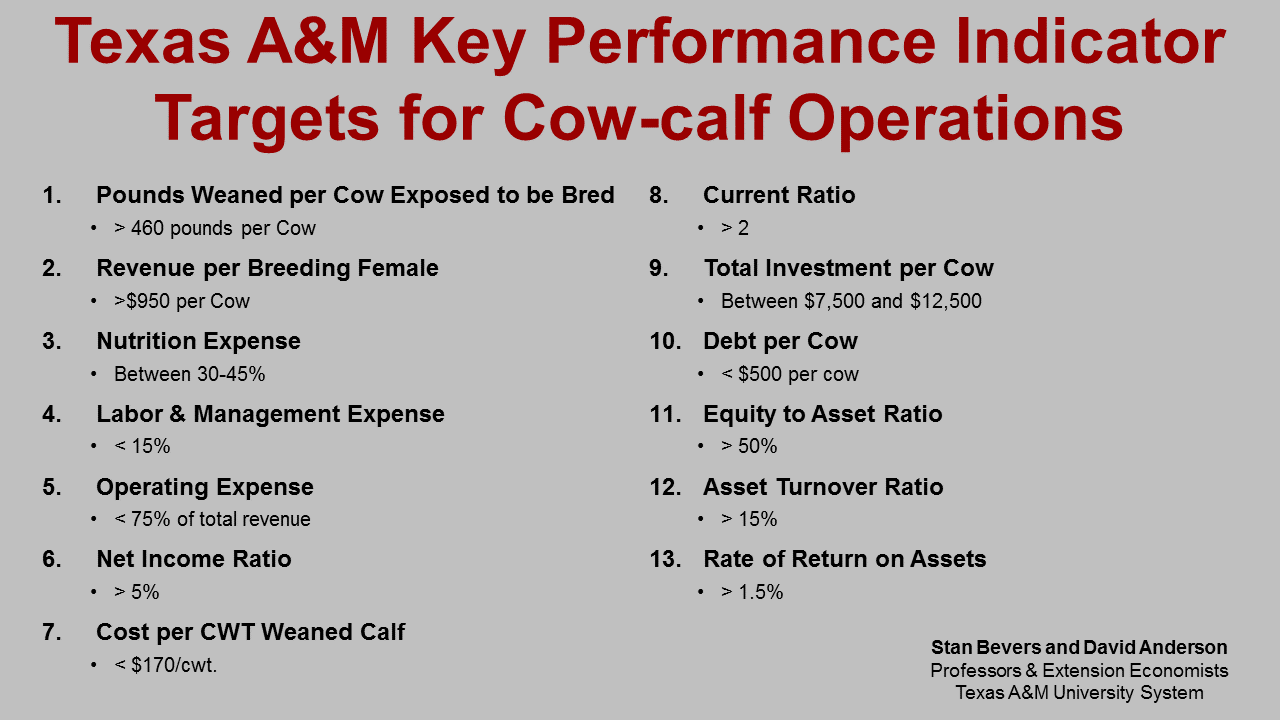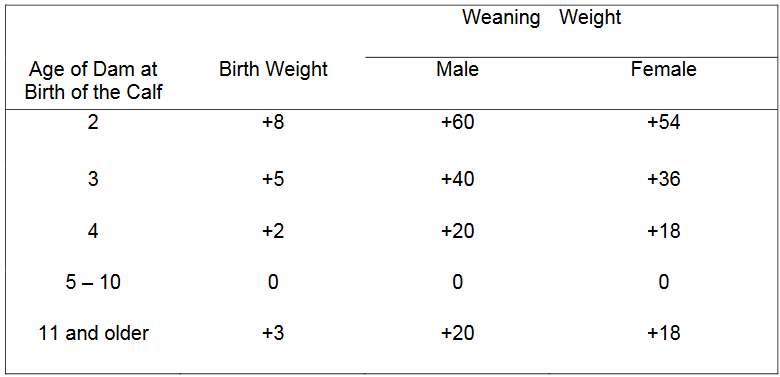
Cattle prices peaked at unprecedented levels in 2014, fell off a cliff in 2015, and took another steep nosedive in 2016. When you look at Figure 1 above you can see that average prices for weaned steers have fallen sharply back to 2010 levels this fall. From July 2015 to October 2016 the US average 550 lb. steer priced dropped from $282/cwt to $125/cwt, a 55% decline in just 15 months. The general consensus of livestock economists is that prices will continue to decline through the rest of this decade as the impact from national herd expansion takes effect. Clearly the cattle business that had been so rewarding for the past three years has become much more challenging to remain profitable.
To survive this downturn, beef cattle ranchers will have to more closely evaluate both input investment and the resulting herd performance with enough precision to make accurate decisions. The first thought most people have, when faced with seriously declining prices, is to simply tighten the belt and spend less. However, there is an age-old adage shared by many successful ranchers that “You can’t starve a profit out of a cow, but you can sure feed it out of a her.” The point of this saying is valid, the key to profitability is not necessarily how much you spend, but getting greatest return from the investments you make. Spend too little and performance is drastically impacted. If you greatly reduce pasture fertilization and supplementation to reduce cost, there is a resulting loss of productivity from the herd. The other part of this old adage is also true, spend too much and your expenses will exceed income.
In times of high prices, virtually any investment that improved productivity had some level of return. At this stage of the market cycle, however, managing based on estimates is dangerous, rather precise performance measurement and record analysis will be critical to remain profitable. Improving efficiency is the primary goal, but to make real progress you have to analyze each phase of the operation to identify those areas where adjustments can make the greatest impact. To do this, you have to establish some baseline data, summarize and evaluate the data on an operational basis, a per cow and per acre basis, and then set some benchmark targets for the operation to reach in the years ahead. Clear target benchmarks can serve as a simplified report card of efficiency that can be compared from year to year in a consistent manor.
Establishing Baseline Production Data
Probably the simplest place to begin to evaluate and improve ranch efficiency is with cattle production and annual herd performance. The following are some of the key records that can be used to establish baseline data for a beef herd. There are many different types of performance records that can be measured and evaluated, but start with the basics (1-3) on a whole herd level to keep from getting overwhelmed, and then add individual animal data to fine tune the management of your herd.
-
Herd Inventory
This seems simple enough, but this number is constantly changing throughout the year with deaths, births, sales, and purchases, so it is not just how many cows and breeding age heifers are owned in a given year, but at a key point in the year, every year – preferably just before the bulls are turned in with the herd for the start of the breeding season.
-
Pregnancy Rate (%)
Reproduction is a very important aspect of ranch management. Every other phase of production management should focus on getting cows and heifers pregnant in a 70 to 90-day period, so this should be measured annually and the success rate recorded. It also provides a real opportunity to cull open cattle as soon as possible. With no future calf to sell, the cow or heifer becomes the income to offset expenses that have occurred.

-
Weaning Data
The total number, weight, and average weight of calves weaned, preferably at a fairly consistent time each year. If all calves are not weaned and sold at the same time, this number will be much more variable, but can be adjusted based on age.
- Weaning Rate (%) – there are several factors involved with how many calves are actually sold for income each year. For cow-calf producers this is your bottom line, how many live calves do you produce compared to the actual number of cows and heifers that were in the breeding herd when the bulls were turned in.

- Average Cow Production (lbs.) – This is the ultimate production unit measure of a cow-calf operation that sells calves at weaning. This is probably the most common benchmark used to compare year to year, and operation to operation. Notice though, this is different from figuring an average weaning weight, because it includes all the breeding cows, not just the live calves at weaning.

- Weaning Rate (%) – there are several factors involved with how many calves are actually sold for income each year. For cow-calf producers this is your bottom line, how many live calves do you produce compared to the actual number of cows and heifers that were in the breeding herd when the bulls were turned in.
-
Individual Animal Identification
This management practice can have significant impacts on efficiency, if individual production records are compared and are used for replacement selection, culling, and animal performance evaluation. It does take both, however, as the identification number is of limited value if no production history is recorded. Progress can be made utilizing whole herd records and averages, but with a history of production for each individual animal, you can select replacements from the top performing individuals in a herd, and more importantly cull out the poorest performers. The most common numbering system is simply the year and the order of birth (example 29th calf born in 2016 would either be 629 or 296). Another method has emerged with computer based record keeping, because every 10 years there will be another 629, so many breed associations and farms have moved to the alphabet year system (example for 29th calf in 2016 would either be 29D or D29).

-
Individual Performance Data
The list of individual animal performance records that can be maintained is endless, but there are several key records that should be kept for each cow in the herd and the individual calves she produces: birth date, birth weight, sex, calving ease, death loss, calving interval, 205 day adjusted weaning weights, and herd ratios. Ratios compare each individual to the average of the herd (100), so a calf with a 105 ratio is 5% above average for that specific group. Identifying and weighing calves allows a cow production history to be established, to aid with culling and replacement selection decisions.



Establishing Baseline Financial Data
If you are truly in the “cattle business,” then there are some basic financial records needed to build baseline data for a cow-calf herd.
-
Income
This is the type of records folks don’t mind tracking, but some forms may not always get recorded. You want to track every type of income for an operation: weaned calves, cull cows, cull bulls, cull heifers, extra hay, equipment sales, custom work for other operations. Not just total sales, but per unit income ($/cwt, $/bale) as well.
-
Expenses
Every operation has to make purchases and rely on some custom services. Don’t just keep receipts, but track expenses by category, so that each category can be compared.
-
Unit Cost of Production
After adding up the expenses, you can go one step further and determine a cost per cow, or cost per pound of weaned calf. This can also be broken down further for each major category of expenditures. Knowing these basic level unit costs make on-the-run calculations easier as you manage day-to-day operations.
-
Revenue per Cow
How much income did each cow that was exposed to be bred earn for the operation? This can be really helpful as you consider herd expansion or decrease.
-
Profitability
The first question to answer at the end of each year is, “Did your income exceed your expenses?” Be careful with this number, however because there is one key difference between gross income and net income – depreciation. Many of the valuable assets such as cows, trucks, tractors, cow pens, and hay equipment have to be replaced. Hopefully, there will also be also funds left for the management income as well.
Record Keeping Systems
There are a number of options available for both record keeping and analysis of beef cattle herds. Certainly records can be kept on a legal pad, calendar or pocket notebook, but by the end of the year it can be frustrating to sort through random written records. There are a few options available that can add some organization to herd records.
-
Pocket Record Book
The National Cattlemen’s Association (NCBA) has a pocket record system called the IRM Redbook. This system is good because it stays with you wherever you go, but that can also be a bad thing in a rainstorm, muddy cowpens, or if it gets washed in your jeans pocket. The Redbook is a great tool, but it was designed for a single production year. NCBA has also added a companion excel spreadsheet, the Redbook Worksheet, that has the same organization, so records from the pocket record book can be transferred to a computer and kept from year to year.
-
Customizable Record Book
Another option is the Florida Ranch Record Book that provides a loose-leaf notebook record keeping system that can be kept in the truck or office. This system was designed for field use to record beef cattle, pastures, and basic financial records. Because the record sheets are in a notebook, sheets can be added or removed and customized for each individual operation. There are even two sheets to be filled out at the end of each year for simple ranch performance and profit analysis. This record book was not designed to provide a complete financial record list for tax preparation or loan application, but it does provide organization for key records collected in the field for everyday use.
-
Computer Software
The most powerful tools for record keeping and ranch management are computer programs developed specifically for this purpose . Many of these programs allow data entry from electronic identification (EID) tag readers, saving a lot of chute-side number writing. A few even allow mobile phone record entry. Oklahoma State has a fact-sheet called Cow-Calf Production Record Software that provides comparisons of commercially available software packages. Most companies offer a free trial of their software, so you can try it out before purchasing. These software programs allow for organized record entry, but more importantly, very powerful data sort and analysis that is much more tedious with written records or even simple excel spreadsheets.

Ranch Analysis
Once the records are recorded and summarized you will have established some baseline data to better manage a cattle operation. The records are of little value however, without herd and operation level analysis, and then breaking it down to the unit level (per cow, per pound of weaned calf, per bale, etc.) The Noble Foundation has a nice spreadsheet to help with end of the year analysis called Cow Calf Net Return. This is a free Excel spreadsheet you can download, that does the math for you. The goal is to boil down all of the key records to a level that makes decision making more simple in the future. Example: You spent $250/cow on supplemental feed in 2015, so what if you switched to a different system? Instead of having to figure total costs, it is much easier to do the math on a per unit level. This is also very valuable as you market calves, because you will have a fairly clear picture of your breakeven costs on $/lb. basis. The Standardized Performance Analysis (SPA) system was developed to combine both cattle performance and financial records for standardized whole ranch analysis that could be used for comparisons to ranches across the country.
Benchmarks

At the 2016 Florida Beef Cattle Short Course, Dr. Stan Bevers, Texas A&M Livestock Economist, shared his 13 Key Performance Indicator Targets for Beef Cow-calf Operations. He offers some really good suggestions on targets for production and financial management of cow-calf operations. While this type of annual, whole ranch evaluation is ideal, it takes extensive production and financial records to develop this sort of annual benchmark targets.
Final Thoughts
Start with simple record keeping tools, begin whole ranch evaluation at the basic level, and then gradually build your operational analysis. Once annual benchmarks can be set, everyone on an operation can work together to build a profitable, efficient cattle operation that is sustainable through the highs and lows of future cattle markets. The ultimate goal is to have each phase of management summarized, so it is much easier to evaluate different systems, scenarios, or substitutions. For most producers, record keeping and analysis is not what they enjoy most about managing a cattle operation, but once the hard work of developing the system is completed, the ability to make hard decisions based on a known history will be invaluable. There are quite a few resources available to help ranchers work through this process. The following are an assortment of helpful links to information and management tools for beef cattle operations:
Key Resources for Ranch Record Keeping & Analysis
Record Keeping Systems:
Florida Beef Cattle Ranch Record Book (Loose-leaf notebook record system)
NCBA Redbook pocket record book (2017 version now available)
NCBA Redbook Companion Spreadsheet (Purchase a CD or Download at no cost)
Ranch Analysis Spreadsheets:
Cow Calf Net Return (Noble Foundation spreadsheet for end of year analysis)
NCBA Standardized Performance Analysis (SPA) ranch analysis spreadsheet
UF/IFAS Beef Economic Program website (Florida Cow-calf Budget spreadsheet)
Useful fact-sheets:
Cow-Calf Production Record Software (Oklahoma State Fact sheet that compares commercial software programs)
BIF Guidelines for Uniform Beef Improvement Programs
Key Performance Indicator Targets for Beef Cow-calf Operations
 0
0


